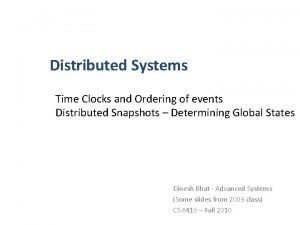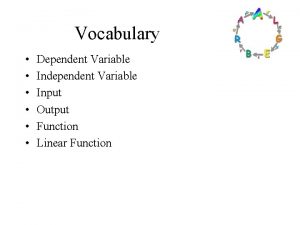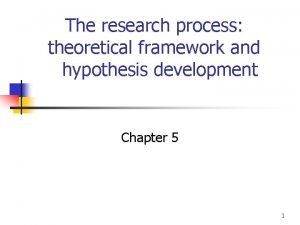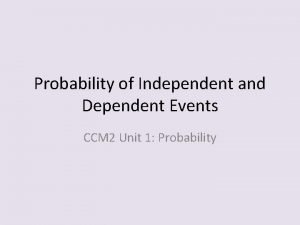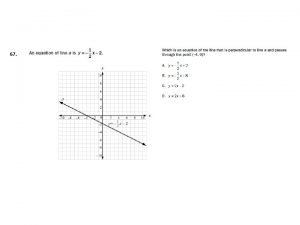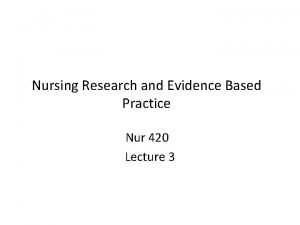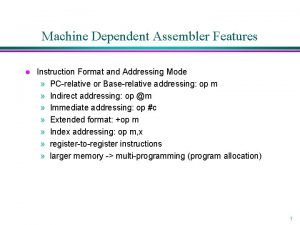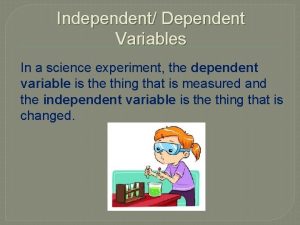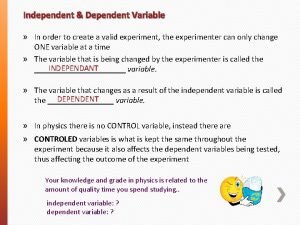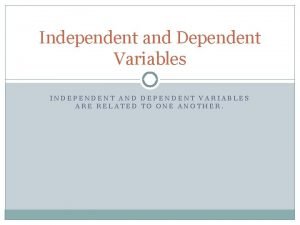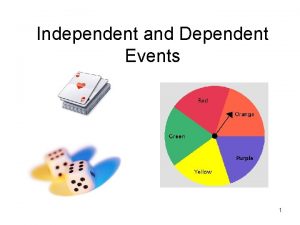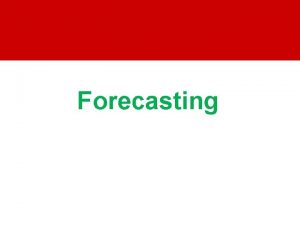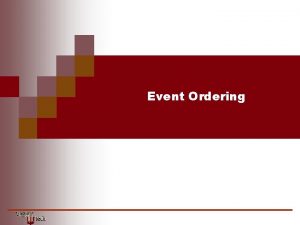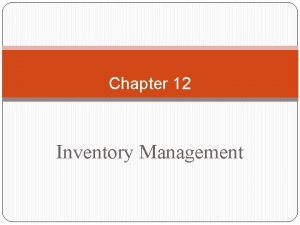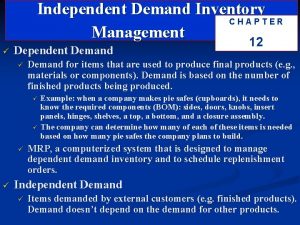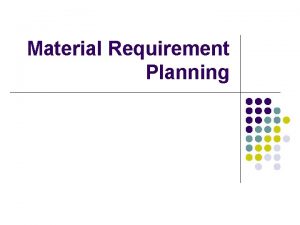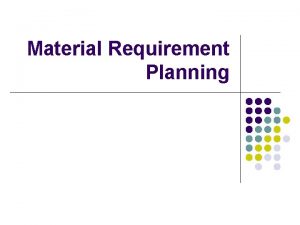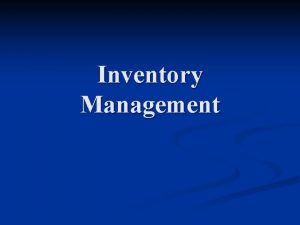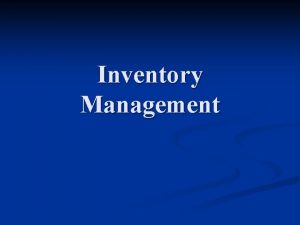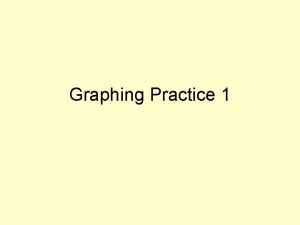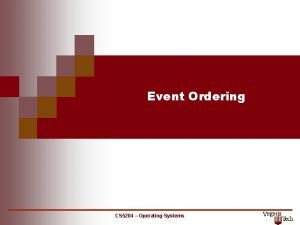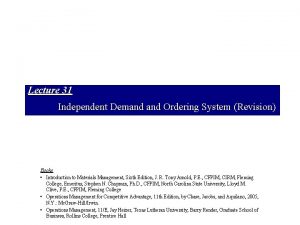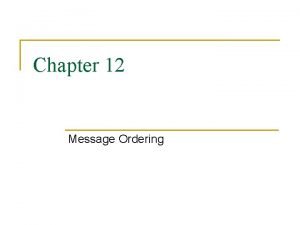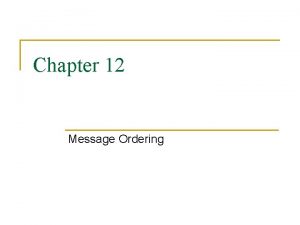Independent Demand Ordering Systems Chapter 11 1 Dependent





























- Slides: 29

Independent Demand Ordering Systems Chapter 11 1

Dependent VS Independent Demand (Demand not related to other items) Dependent Demand (Derived) E(1) 2

Dependent VS Independent Demand Dependent Demand 3

Independent Demand Ordering Systems • Main question now turns to when to place an order? – Stock not ordered early enough may result in a stockout situation – Stock ordered too soon may result in excess inventory – How do you balance the two? 4

Definitions • Lead Time : “The time between recognition of a need for an order and the receipt of the goods” • Order Point: “A set inventory level where, if the stock on hand plus on-order falls to or below that point, action is taken to replenish the stock. ” • Safety Stock: “In general, a quantity of stock planned to be in inventory to protect against fluctuations in demand and/or supply • Service Level: “… the percentage of orders filled from stock…” APICS Dictionary 7 th Edition 5 © 1992

Independent Demand Ordering Systems • Reorder Systems Include: – Order Point System – Periodic Review System – MRP • For dependent demand items 6

Independent Demand Ordering Systems • Order Point Systems – A system where an order is placed whenever the onhand inventory level falls to a predetermined level known as the order point • Quantity ordered is usually predetermined and based on the EOQ • An order must be placed when there is enough stock on hand to satisfy demand from the time the order is placed until new stock arrives 7

Independent Demand Ordering Systems • The Order Point – The point where there exists enough inventory on hand to equal the demand during the lead time plus some safety stock. Order Point = Demand During Lead Time + Safety Stock OP = DDLT + SS – Note that the demand during lead time is important as this when a stockout could occur. 8

Example: Order Point Q: Demand is 100 units a week, the lead time is three weeks, and the safety stock has been established at 300 units. Calculate the order point. A: Order Point = ? DDLT = (100 units per week x 3 weeks) SS = 300 units OP = DDLT + SS = (100 x 3) + 300 = 600 units 9

Independent Demand Ordering Systems • Order Point Units in Stock Q = Order Quantity Order Point Safety Stock Lead Time Average Inventory = Q/2 + SS 10

Example: Average inventory Q: Order quantity is 7000 units and safety stock is 900 units. What is the average annual inventory? A: Average inventory = Q/2 + SS = 7000 + 900 = 4400 units 2 11

Independent Demand Ordering Systems • Uncertainty – Quantity uncertainty • When the amount of supply or demand varies – Timing uncertainty • Time of receipt of supply or demand differs from that expected – Two ways to protect: • Carry extra stock (safety stock) • Order early (safety lead time) 12

Independent Demand Ordering Systems • Safety Stock – SS is used to protect against uncertainty in supply and demand. – SS depends on: • • Variability of demand during lead time Frequency of reorder Service level desired Length of lead time 13

Independent Demand Ordering Systems • Variability of Demand – Actual demand will vary from the forecast due to bias and random fluctuations. – Usually the variation of demand will follow a normal distribution (bell curve) 14

Independent Demand Ordering Systems • Variability of Demand – Actual demand will be -1 Sigma -3 Sigma -2 Sigma +1 Sigma +2 Sigma +3 Sigma 15

Average & Dispersion 16

Mean Absolute Deviation Forecast D Actual D Deviation 100 66 34 100 110 10 100 131 31 100 103 3 100 96 4 100 119 19 100 92 8 100 0 100 80 20 17

Standard Deviation (Sigma) Forecast Demand Actual Demand Deviation Dev Squared 100 66 34 1156 100 110 10 100 131 31 961 100 103 3 9 100 96 4 16 100 119 19 361 100 92 8 64 100 0 0 100 80 20 400 Total 3067 18

Independent Demand Ordering Systems • Determining Safety Stock – SS is needed only to cover those periods in which the demand during lead time is greater than average. – Service level is a statement of the percentage of time there is no stockout – Safety Factor is derived from the service level 19

Independent Demand Ordering Systems • Safety Stock Equation • Safety Stock = (Sigma x Safety Factor) 20

Example: Safety Stock & Order Point Using the figures in the last example problem in which the sigma was calculated as 18. 5 units Safety Stock = (Sigma x Safety Factor) Q: a) Calculate the safety stock and order point for an 84% service level. A: Safety stock = Sigma x safety Factor = 18. 5 x 1. 00 = 18. 5 units Order point = DDLT + SS = 100 + 18. 5 = 118. 5 units From safety factor on page 291 21

Example: Safety Stock & Order Point Using the figures in the last example problem in which the sigma was calculated as 18. 5 units Safety Stock = (Sigma x Safety Factor) Q: b) If a safety stock equal to 95. 5% is carried, calculate the safety stock and the order point. A: Safety stock = Sigma x safety Factor = 18. 5 x 1. 65 = 30. 525 or 31 units Order point = DDLT + SS = 100 + 31 = 131 units 22

Safety Factor Generated using Excel function NORMSINV 23

Example: Safety Stock & Order Point Q: If the standard deviation is 18. 5 units, what safety stock should be carried to provide a service level of 90%? If the expected demand during the lead-time is 500 units, what is the order point? A: The safety factor for a service level of 90% is 1. 28 Safety stock = sigma x safety factor = 18. 5 x 1. 28 = 23. 68 or 24 units Order point = DDLT + SS 24

Independent Demand Ordering Systems • Service Level – Stockouts lead to costs such as • • • Back-order costs Lost Sales Lost Customers • Possible only when stock is running low, usually the time when an order is placed • Chances of a stockout are directly proportional to frequency of reorder 25

Independent Demand Ordering Systems • Service Level – The service level will determine the number of stockouts that will occur each year. – Service level decisions are the responsibility of senior management and should reflect the company’s corporate and marketing strategy. 26

Independent Demand Ordering Systems • Determining When the Order Point is Reached – Two-Bin System • A quantity of an item equal to the order point is set aside and not touched until the main stock has been used • Variations include tags and indicators Order One Bin of Inventory Full Empty 27

Independent Demand Ordering Systems • Determining When the Order Point is Reached – Perpetual Inventory System • A continual account of inventory transactions as they occur • Contains “permanent” and “variable” information – Barcoding 28

Independent Demand Ordering Systems • Periodic Review System – The quantity on hand of a particular item is determined at specified, fixed-time intervals. – The review period is fixed and the order quantity is allowed to vary. – The quantity on hand plus the quantity ordered must be sufficient to last until next shipment is received. 29
 What is dependent demand inventory
What is dependent demand inventory Independent and dependent demand
Independent and dependent demand Independent demand inventory system
Independent demand inventory system Message ordering in distributed systems
Message ordering in distributed systems Time clocks and the ordering of events
Time clocks and the ordering of events Independent variable
Independent variable What is a dependent variable in science
What is a dependent variable in science Experimental design independent and dependent variables
Experimental design independent and dependent variables Theoretical framework independent dependent variable
Theoretical framework independent dependent variable Theoretical framework independent dependent variable
Theoretical framework independent dependent variable Research framework and definition of variables
Research framework and definition of variables Research variables meaning
Research variables meaning Identify independent and dependent events
Identify independent and dependent events Two events are independent
Two events are independent Difference between light dependent and light independent
Difference between light dependent and light independent Independent variable and dependent variable in research
Independent variable and dependent variable in research Rho independent termination
Rho independent termination Machine dependent loader features
Machine dependent loader features Machine dependent assembler features in system software
Machine dependent assembler features in system software Chapter 4 vector spaces
Chapter 4 vector spaces Field dependent vs field independent
Field dependent vs field independent How to determine the independent variable
How to determine the independent variable Dependent clause and independent clause
Dependent clause and independent clause Independent variable science
Independent variable science What side does the independent variable go on a graph
What side does the independent variable go on a graph Dependent variable independent variable
Dependent variable independent variable What is continuous data
What is continuous data Independent or dependent
Independent or dependent Independent vs dependant events
Independent vs dependant events Dependent events examples
Dependent events examples




